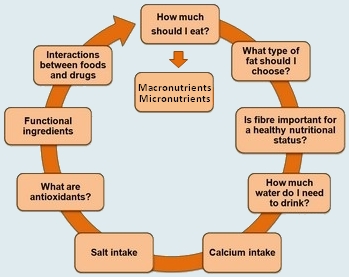
What you should know
Nutritional education of the population is extremely important, especially for elder people.
Its main aim is to seek a general improvement of nutritional status by promoting proper and healthy eating habits thus eliminating an inadequate diet, introducing best practices of food hygiene and a more efficient use of food resources.
With advancing age some nutritional needs can be different. Please follow carefully the next topics to understand how you can know which are your nutritional needs. Please consider that these are general recommendations.

- Nutritional assessment of the elderly is complex! Calorie intake should be calculated individually and be suitable for each age.
- Be aware of the lack of regular appetite, in advanced age, with the decrease of muscle mass, physical activity and calories spent, the body does not need as much food as before...
- It is still very important to perform an adequate intake of nutrients and energy for maintenance, wellness and health!
General recommendations for healthy eating
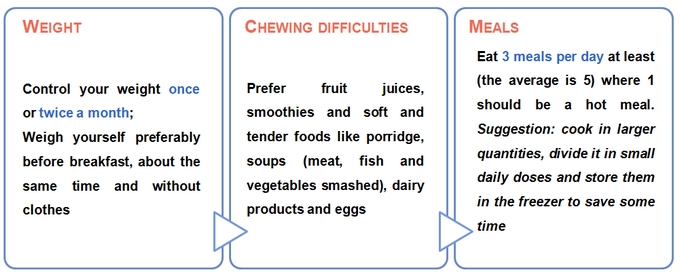
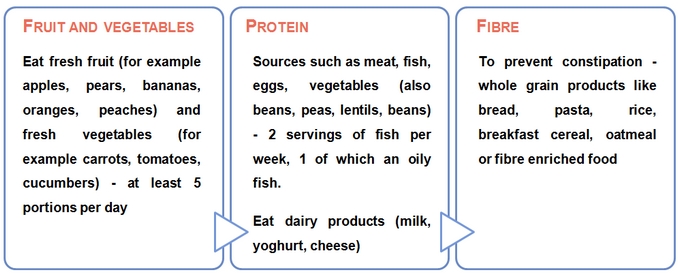
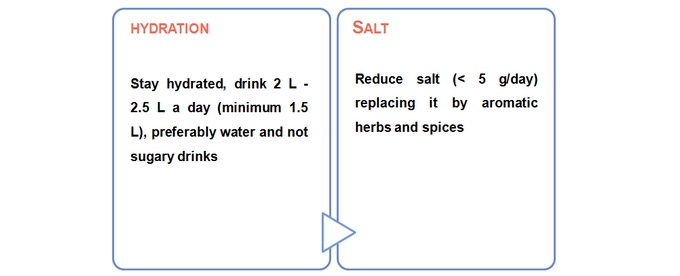
Example of a daily dietary plan for 2000 calories:
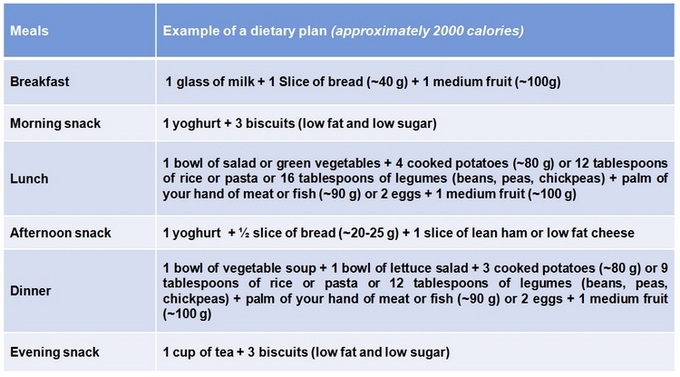
Food Equivalences
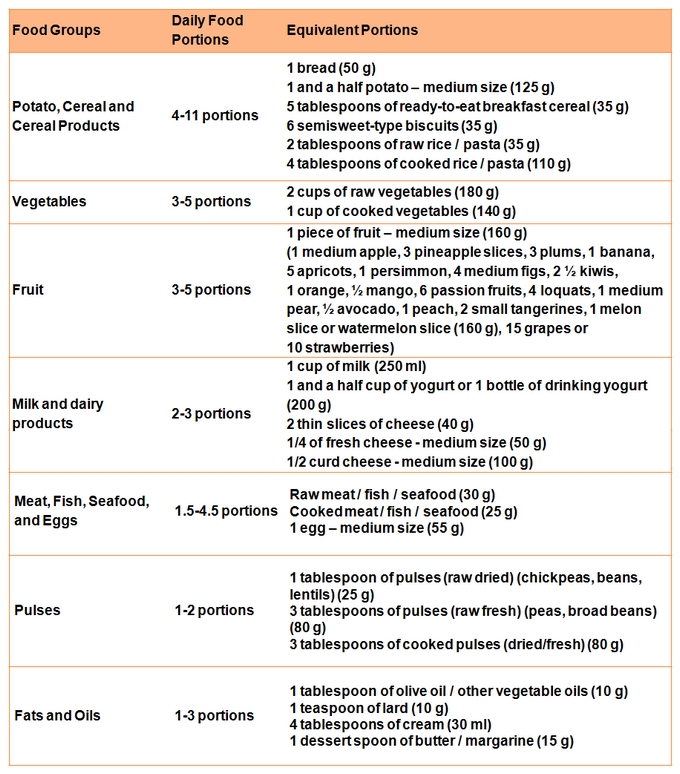
Serving sizes - Portions
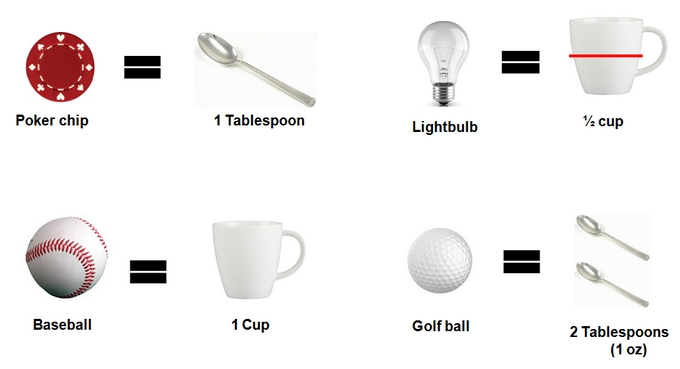
Meal example using portions
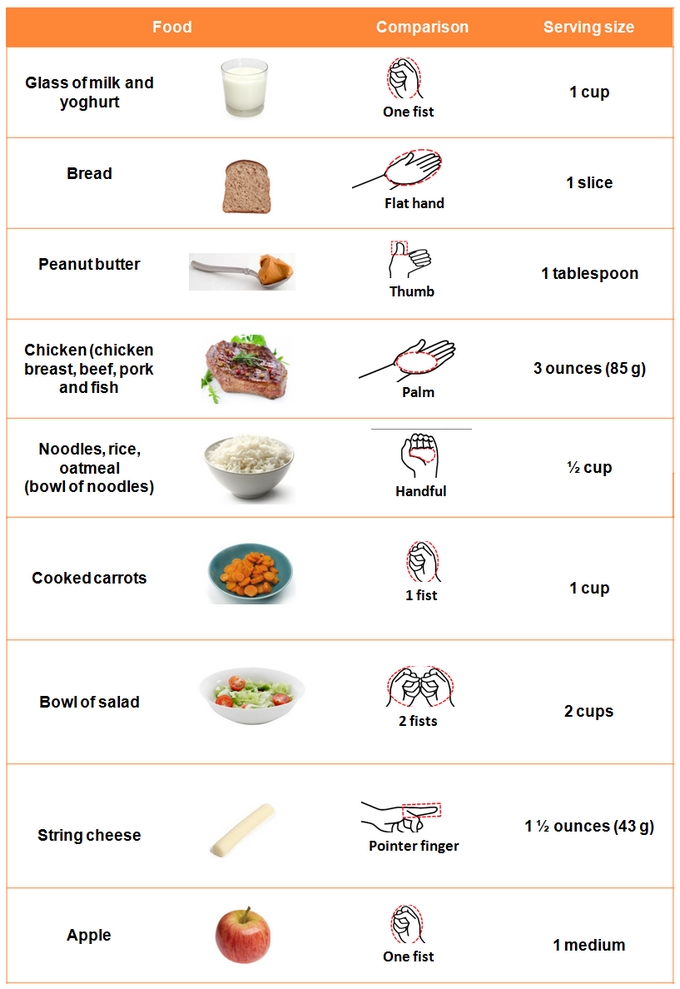
(Source: healthyeating.org)
Other useful portions
1 cup of flaked cereal or a baked potato = fist 2 tablespoons of peanut butter or cream cheese = golf ball Meat or poultry, tofu, 1 slice of cake (85 g) = deck of cards Grilled/baked fish (85 g) = check book 1 slice of bread = cassette tape 1/2 cup of fruit, rice, pasta, or ice cream = 1/2 baseball or cupcake wrapper 1 cup of salad greens , cooked vegetables, baked potato, cereal flakes, 1 medium fruit, 1 cup yoghurt = baseball 1/2 cup grapes = about 16 grapes 1 cup strawberries = about 12 berries 1/4 cup = 12 almonds or 24 pistachios 1 teaspoon of butter or margarine = tip of your first finger 1 portion of lean meat = palm of your hand Nuts (30 g) = hand full 1 portion of cheese (30 g) = your first finger 1 cup or 2 portions of pasta or oatmeal = your fist 1 quarter cup raisins = large egg Cheese (42.5 g) = 3 staked dice or 3 - 4 dice 1/2 cup of cooked rice, 1/2 cup cooked pasta = light bulb 1 piece chocolate, 1 brownie = dental floss package 1 cookie = about 2 poker chips 1 pancake or tortilla = compact disc or DVD
(Source: Kathleen Zelman, MPH, RD, LD, Director of Nutrition for WebMD. Reviewed on November 26, 2008; National Institute on Aging)
Physical Activity - Lifestyle
Sedentary Includes only the light physical activity associated with typical day-to-day life.
Moderately active Equivalent to walking about 1.5 to 3 miles per day (2.5 to 5 km/day) at 3 to 4 miles per hour (5 to 6 km/h), in addition to the light physical activity associated with typical day-to-day life.
Active Equivalent to walking more than 3 miles per day (5 km/day) at 3 to 4 miles per hour (5 to 6 km/h), in addition to the light physical activity associated with typical day-to-day life.
Estimated calorie needs per day by age, gender, and physical activity level
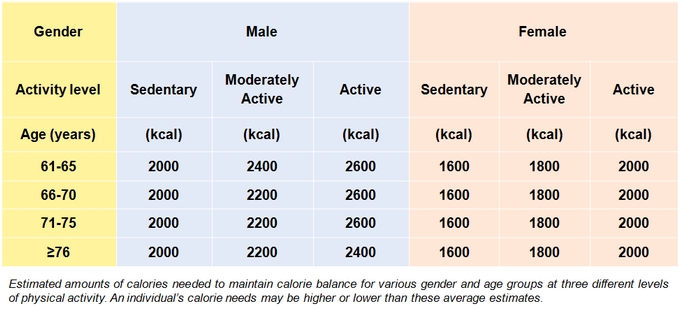
(Source: Dietary guidelines for Americans 2010)
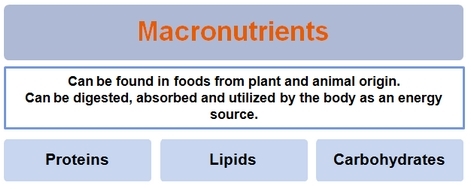
Proteins

Functions: - Growth, repair, functioning and structure of all living cells.
Main sources of plant origin: - Legumes, nuts, vegetables and seeds.
Main sources of animal origin: - Meat, fish, eggs, milk, cheese and yogurt.
Daily needs and energy value: - About 10-15% of your total energy intake should come from proteins; 1 g of protein is equivalent to 4 kcal.
Lipids

Functions: - Main energy source; Transport of vitamins A, D, E and K and antioxidants; Insulating and thermal protection around vital organs.
Main sources of plant origin: - Seeds (rapeseed, cottonseed, sunflower, peanut, corn and soybean), Nuts (walnuts, almonds, hazelnuts and peanuts), Oils (olive oil, sunflower oil, soybean oil and palm oil).
Main sources of animal origin: - Meat, Oily fish (salmon, sardines, mackerel and trout), Eggs, Dairy products (cheese, butter and sour cream).
Daily needs and energy value: - About 15-30% of your total energy intake should come from lipids; 1 g of lipids is equivalent to 9 kcal.
Carbohydrates
Simple carbohydrates are quickly digested and absorbed giving us less satiety. Complex carbohydrates are digested and absorbed more slowly than simple carbohydrates making us feel satiated for a longer time. These are the best option!

Functions: - Provide energy; Important role in the structure and function of cells, tissues and organs.
Main sources of simple carbohydrates: - Sugar, Cakes, Soft drinks.
Main sources of complex carbohydrates: - Cereals, Potatoes, Rice, pasta and bread, Legumes (beans, chickpeas, lentils).
Daily needs and energy value: - About 55-75% of your total energy intake should come from carbohydrates; 1 g of carhohydrates is equivalent to 4 kcal.
Carbohydrates are made up of sugar and can be classified according to the number of sugar units combined together to form a molecule.
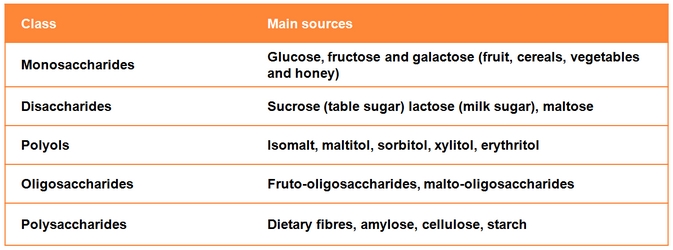
According to the World Health Organization (WHO) your nutritional needs are:

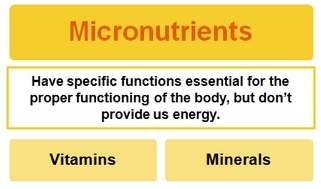
Vitamins
There are water-soluble vitamins and fat-soluble vitamins, both essential for our body.
Water-soluble vitamins
- Complex B vitamins: vitamin B1 (thiamin), vitamin B2 (riboflavin), niacin, vitamin B6, folate, vitamin B12 (cobalamin), biotin and pantothenic acid. Main sources: Cereal grains, meat, poultry, eggs, fish, milk, legumes and fresh vegetables
- Vitamin C Main sources: orange, lemon, kiwi, mango, broccoli
Fat-soluble vitamins
- Vitamin A (Retinol), Vitamin D (Calciferol), Vitamin E (alpha-tocopherol) and Vitamin K Main sources: Vegetable oils, fatty fish, dairy products, eggs and dark leafy vegetables
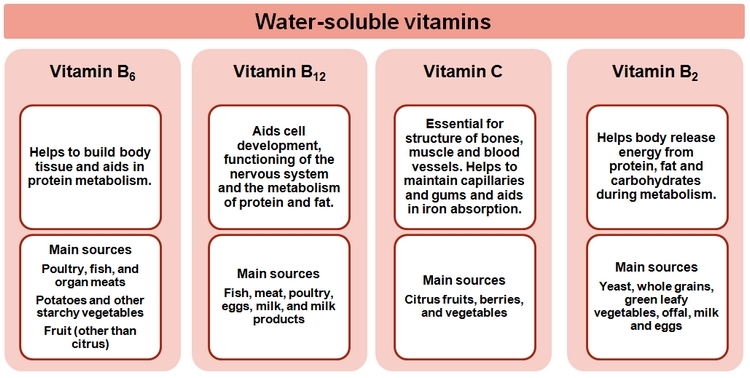
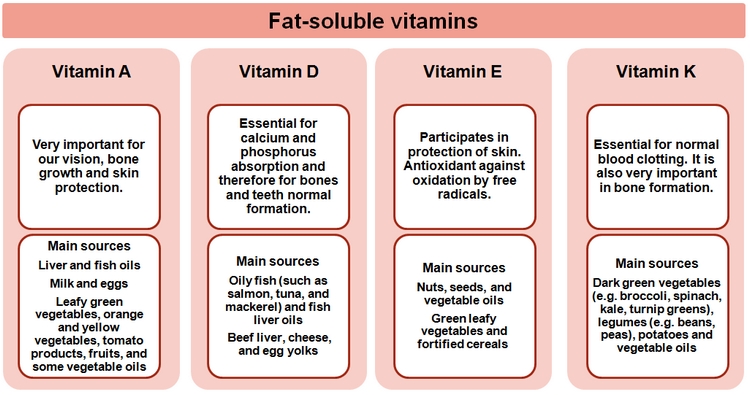
Minerals
Minerals that have major needs of consumption (mg / day): - Calcium, phosphorus, magnesium, sodium, potassium and chloride.
Minerals that have minor needs of consumption (micro g / day): - Iron, zinc, selenium, iodine, fluoride, copper, manganese, chromium and molybdenum.
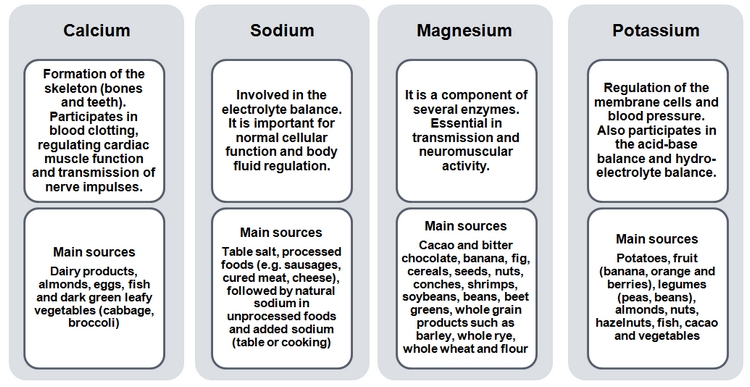
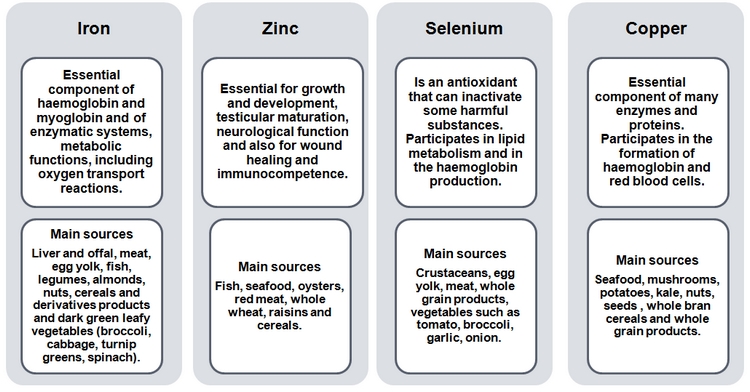
Recommendations per day for some vitamins and minerals according to elderly needs:
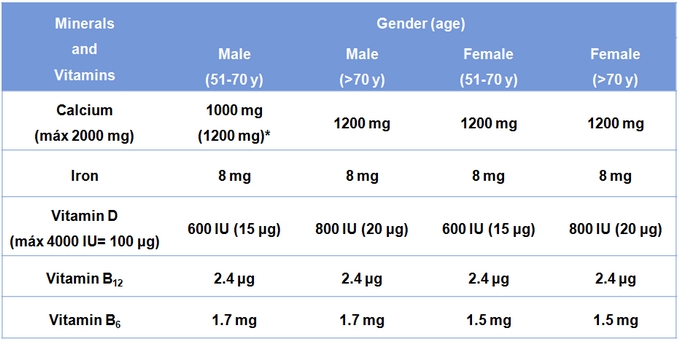
(Sources: National Academy of Sciences (2010) and *Dietary guidelines for American 2010)
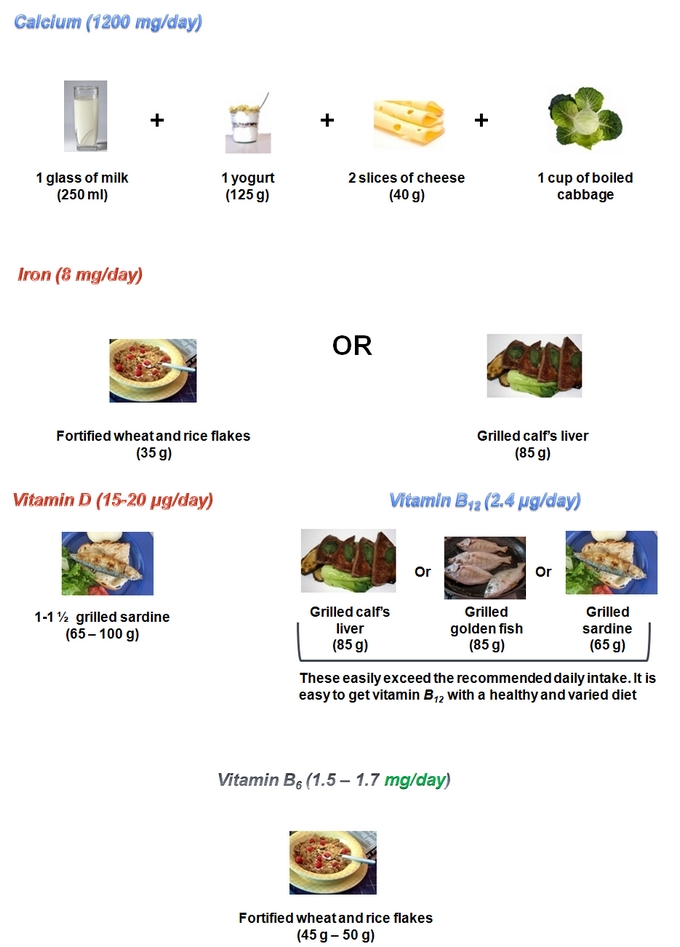
Fat is the richest source of dietary energy available in the diet: 1 g of fat = 9 kcal
Most of the unsaturated fatty acids can be synthesized in our body.
Fat is an important structural component of cells and membranes in our body, and is essential for the transport of fat-soluble vitamins (A, D, E and K).
Essential fatty acids cannot be synthesized in the body but are needed for our normal physiological functioning. Therefore, these have to be supplied by the diet.
Besides the total amount of ingested fat, it is of great importance to know which type of fat it is. Depending on the fatty acids profile of foods, the risk for cardiovascular disease can be increased.
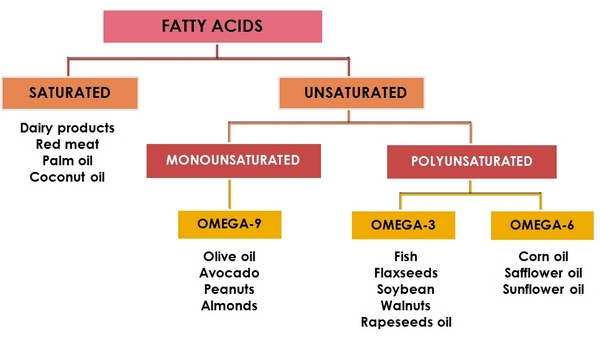
Saturated fatty acids
Generally, fats rich in saturated fatty acids are solid at room temperature and tend to be from animal origin.
Some of the main sources of this type of fatty acids are: high fat cheeses, butter, lard, whole-fat milk and cream, palm and coconut oils, meats rich in fat, and some charcuterie products (pork cured ham, smoked ham, bacon).
Monounsaturated fatty acids
Generally, oils containing polyunsaturated fatty acids are liquid at room temperature but start to turn solid when chilled.
Some of the main sources of this type of fatty acids are: oils (olive, canola, peanut and sesame); nuts (macadamia, almonds, peanuts, hazelnuts); seeds (sesame, pumpkin); and fruits (avocados and olives).
Polyunsaturated fatty acids
Generally, fats rich in polyunsaturated fatty acids are liquid at room temperature.
Some of the main sources of this type of fatty acids are: walnuts, sunflower seeds, flaxseeds, salmon, sardines, mackerel, trout, and oils (sunflower, corn and soya).
Omega-3
Promote the proper functioning of the cardiovascular system by preventing the onset of heart disease and have shown to be very important in people who have already suffered a heart attack. In the elderly, they also have a key role in relieving the symptoms of Rheumatoid Arthritis, sensitive or swollen joints and mobility, in eye health, in the system immune improvement, in the prevention of cognitive functions decline. Fish oil and flax seeds are rich in these fatty acids.
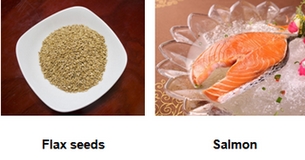
For more information on omega-3, see "Functional ingredients".
Omega-6
Promote good brain development, cellular and skin protection among others. Vegetable oils (e.g. peanut oil, soybean, sunflower, maize) are rich in these fatty acids (e.g. linoleic acid). Nuts, whole grains and seeds are rich in these fatty acids.
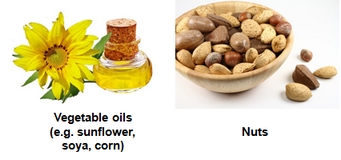
For more information on omega-3, see "Functional ingredients".
Hydrogenated fat and hydrogenation process
The hydrogenation process of vegetable oils is the conversion of the liquid into the solid and/or paste form. This industrial process is used to manufacture margarine and other vegetable fats.
Hydrogenation of unsaturated fatty acids is one of the main processes that induces trans fatty acids formation. The intake of these type of fatty acids is related with harmful effects on your health.
Examples of main sources:
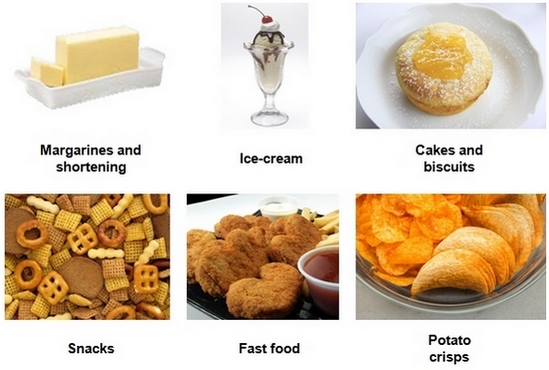
trans fatty acids
Monounsaturated and polyunsaturated fatty acids may have two different structural forms scientifically described as cis and trans form.
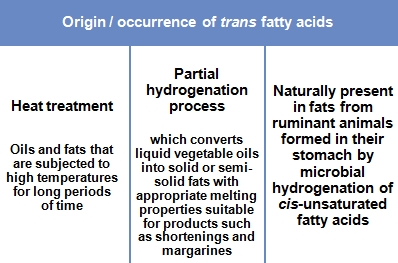
Health effects related with a high intake of trans fatty acids:
- trans fatty acids intake is associated with an undesirable effect on serum lipid profiles, and thus may increase the risk of cardiovascular diseases, being considered in this respect, worse than saturated fat.
- With respect to other chronic diseases such as, obesity, diabetes and cancer, scientific studies have provided controversial results. Therefore, trans fatty acids intake should be as low as possible within the context of a nutritionally adequate diet.
Cholesterol
Cholesterol is an essential fat in our body. It has two sources:
- Endogenous - produced by the body, particularly in the liver - Exogenous - obtained through food such as meat, eggs and dairy products.
Functions : the body needs cholesterol to produce hormones, cell walls, vitamin D and bile acids that help our digestion. However, our body only needs a small amount of cholesterol to meet its needs.
Examples of main sources:

Phytosterols
Phytosterols are found in all plant foods, with the highest concentrations occurring in vegetable oils. These are essential components of the structure of cell membranes of plants.
The intake of phytosterols is related with a decrease of the intestinal absorption of cholesterol. Decreases the risk of cardiovascular diseases and prevents some types of cancer (e.g. colon, breast and prostate).
Generally, phytosterols are present in low amounts in foods. However, there is a range of products fortified with phytosterols in the market (e.g. margarines, milk and yogurts).
Examples of natural main sources and fortified foods:

Culinary uses of fat

Recommendations with respect to the uses of fat
- Prefer low fat milk and its low fat derivatives (ex. yogurt, cheese).
- Prefer fish (fresh or deep-frozen) and lean meats (e.g. poultry and rabbit) instead of fat meat (e.g. beef, pork, lamb). If you do eat red meat, choose lean cuts.
- Remove the skin and visible fat from meat and poultry (before cooking and on the plate, if necessary).
- Prefer olive oil for cooking and seasoning, limiting the amount used in the plate; in addition other dressings can be used (e.g. lemon, vinaigrette or non-fat yogurt).
- Use breadcrumbs or low fat cheese to gratin.
- Reduce the amount of butter or margarine spread on bread.
- Avoid fried food. Prefer baked, grilled and stewed which requires less fat.
- Always read the food label and choose the product with the least amount of fat.
What is dietary fibre?
Dietary fibre is related to the edible parts of vegetables that our small intestine is unable to digest and absorb, so they reach the large intestine intact.
Main physiological effects
Improves the intestinal function - helps preventing constipation and also can act as a laxative; Decreases the blood glucose levels and blood cholesterol - improves glycaemic control in diabetic subjects and reduces low density lipoprotein cholesterol (LDL); Satiating effect - foods high in fibre tend to have a high volume and low energy density, helping to reduce hunger; Contributes to weight control.
Dietary needs and energy value
25 g/day -- 1 g of dietary fibre is equivalent to 2 kcal

Soluble fibre
Main physiological effects
Well functioning of the intestine Increasing feeling of satiety Regulation of the hormones produced in the stomach and pancreas Decrease and maintenance of cholesterol levels and blood sugar (glucose) after meals
Main food sources
Oatmeal, oat cereal, lentils, apples, oranges, pears, oat bran, strawberries, nuts, flaxseeds, beans, dried peas, blueberries, psyllium, cucumbers, celery, and carrots.
Insoluble fibre
Main physiological effects
Increase of the bulk of the fecal mass Intestinal transit acceleration preventing the appearance of hemorrhoids and some types of cancer (colon and rectum)
Main food sources
Whole wheat, whole grains, wheat bran, corn bran, seeds, nuts, barley, couscous, brown rice, bulgur, zucchini, celery, broccoli, cabbage, onions, tomatoes, carrots, cucumbers, green beans, dark leafy vegetables, raisins, and grapes.
What type of bread should I choose?


General information
Water plays many important roles within the body.
Our body consists of 60%-70% of water.
In average, an adult eliminates 3 litres of water per day through urine, sweat and breathing.
Dehydration
Dehydration occurs when the body loses more water than it is consumed.
Dehydration can also be a consequence of diarrhoea and vomiting.
Dehydration is more common in children and the elderly.Chronic dehydration can increase the risk of infection.
Symptoms of slight dehydration (higher or equal to 1%) are thirst, weakness, dizziness, headaches and fatigue.
Dehydration can be fatal when it reaches a loss of 10% of body weight.
Water requirements
According to the European Food Safety Authority (EFSA) daily needs (including water, food and beverages) are 2.5 L for men and 2 L for women.
We have the "old habit" of drinking water only when we are thirsty. The issue is that we often do not feel this desire even though our body is physiologically "thirsty"!
The elderly may not achieve the necessary water intake due to decreased appetite and thirst, medication, immobility or illness.
Sources of water
Water is present in many foods that can be a part of your daily meals. Considerable amounts of water can be found in soups, smoothies, fruit juices, tea, coffee, fruit and vegetables.
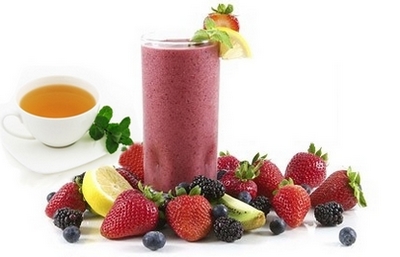

Calcium
Calcium is a mineral and one of the most abundant elements in our body!
According to the World Health Organization: a balanced diet rich in calcium may reduce the risk of injuries from falls in the elderly.
Falls in elderly and osteoporosis are very frequent. Therefore an adequate intake of calcium during life is very important.
Calcium has a key role in bone formation, protection and maintenance of bones and teeth along with vitamin D and K.
Deficiency or excessive intake
Causes of deficiency:
- Insuficient intake - Hormonal problems - Other diseases
In response our body pulls calcium from the bones to replenish this shortage, occurring bone decalcification:
- Osteopenia (initial phase of bone mass loss) - Osteoporosis
Osteoporosis:
Common bone disease characterized by low regeneration and/or rapid bone degeneration, giving rise to little dense and porous bones becoming "brittle and fragile" which becomes responsible for an increased risk of bone fractures and consequently for millions of fractures annually (lumbar vertebrae, hips and wrists are the most common). More common in women (especially after menopause) than in men and after 50 years of age.
Excessive intake:
- Causes the well known "stone" (calcium oxalate) in the kidney; - Reduces the absorption of other minerals such as magnesium.
Recommended dietary allowance (RDA)
European recommendations:
- Women over 50 years: 1200 mg/day - Men 51-70 years: 1000 mg/day - Men over 70 years: 1200 mg/day - Men and women above 51 years: maximum 2000 mg/day
American recommendations:
- Men and women = 51 years: 1200 mg/day
Supplementation should be supervised by an health expert.
Dietary sources
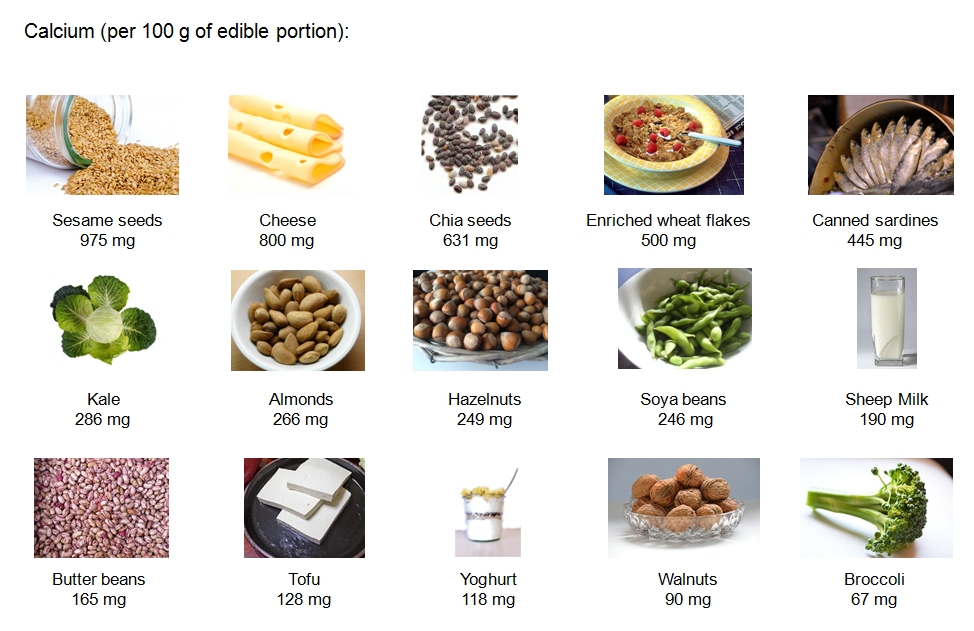

Salt
Salt is used as an ingredient, as a flavour, or for food preservation to control microbial growth.
Salt is an important component of foods, being responsible for flavour and texture.
Nonetheless, its excessive intake is related with an increased risk for the development of hypertension.
With respect to its presence in foods: about 10% is naturally present in foods, 15% is added during cooking or at the table, and 75% is incorporated during manufacture and processing of foods.

Hypertension
"Hypertension, also known as high or raised blood pressure, is a condition in which the blood vessels have persistently raised pressure, putting them under increased stress".
Globally cardiovascular disease accounts for approximately 17 million deaths a year, nearly one third of the total. Of these, complications of hypertension account for 9.4 million deaths worldwide every year.
Most of the people that have this chronic disease, do not have symptoms, making the diagnosis difficult.
(Source: WHO, 2013)
How to evaluate your blood pressure?
Blood pressure is measured in millimetres of mercury (mm Hg) and is recorded as systolic blood pressure and diastolic blood pressure.
Normal adult blood pressure is defined as a systolic blood pressure of 120 mm Hg and a diastolic blood pressure of 80 mm Hg.
Classification of blood pressure for adults:
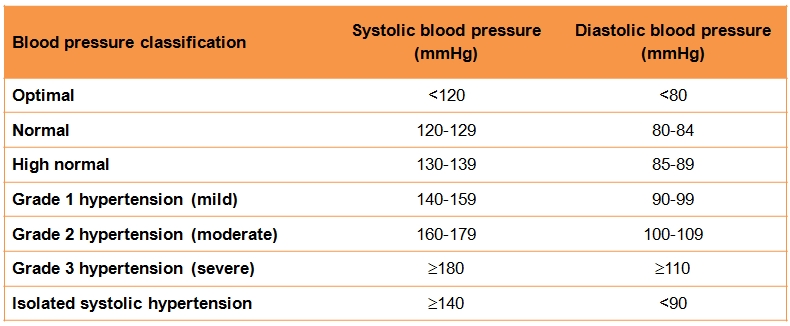
(Adapted from World Health Organization, Regional Office for the Eastern Mediterranean. (2005). Clinical guidelines for the management of hypertension. Metropole, Cairo.)

Due to the importance of this parameter please take in account some recommendations:
- Sit quietly with back supported for 5 minutes, with arm bared and supported at the level of the heart; - No caffeine, smoking or alcohol 30 minutes prior to measurement; - On each occasion, measure at least twice separated by a feasible period of time (at least 5 minutes); - For diagnosis, obtain at least two sets of readings at least a week apart; - Note the pressure, your position and the arm used (e.g. 140/90 mmHg, seated, right arm).
Recommended dietary intake
World Health Organization, has called on all countries to reduce the average population salt intake to less or equal to 5 g / day with the aim of reducing salt intake by 30% by 2025.
EU salt reduction activities have been concentrated on a limited number of food categories. Specifically, 12 categories of food are identified:

- bread - meat products - cheese - ready meals - soup - breakfast cereals - fish products - crisps, savoury snacks - catering meals - restaurant meals - sauces, condiments and spices - potato products
(Source: Mapping salt reduction initiatives in the WHO European Region, World Health Organization, 2013.)
Dietary sources (examples)
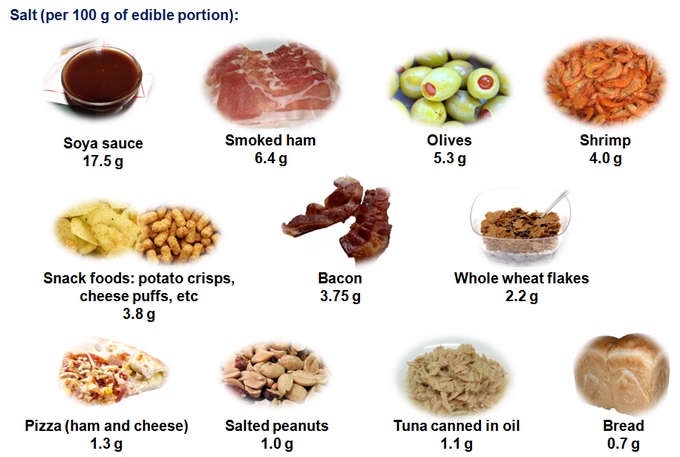
(Source: Tabela de Composicao dos Alimentos, 2007.)

General advices
- Always read the food labels and check the salt content - Some of the manufacturers are updating their food labels. Therefore in some cases you can find in the label the term "sodium" instead of "salt": salt = sodium x 2.5 (e.g. 5 g salt is approximately 2 g sodium) - Taste your meals/foods before adding salt - Avoid the salt shaker on the table - Replace salt by aromatic plants, spices and/or lemon juice
What are Functional Ingredients?
Functional ingredients are natural substances that have health promoting or disease preventing benefits. Foods fortified with functional ingredients have gained increasing popularity in the food industry.
Here are some examples of functional ingredients:
beta-SITOSTEROL; β-SITOSTEROL
β-Sitosterol is a chemical substance similar to cholesterol that is a common constituent of plants and is known for its medicinal properties.
β-Sitosterol is added to some margarines or to milk as part of a cholesterol-lowering diet for the prevention of heart disease. The federal Food and Drug Administration (FDA) allows manufacturers to claim that foods containing beta-sitosterol reduce the risk of coronary heart disease by lowering blood cholesterol levels.
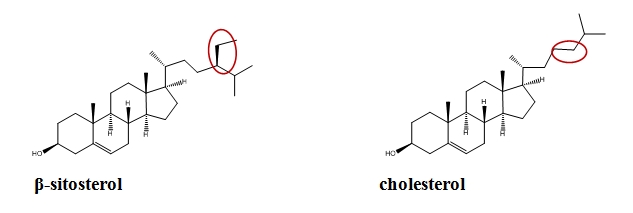
It can be found in:
- Plants, including herbs (plants used for food, flavoring, medicine, cosmetics)

Clinacanthus nutans Lindau is a well-known medicinal plant in South-East Asia traditionally used for the treatment of hepatitis, snake venom poisoning, and also applied for treatment and prevention of cancer diseases.
- Fruits, like cashew and avocado
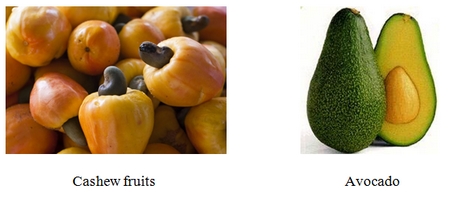
- Wheat germ, rice bran, corn oils and soybeans
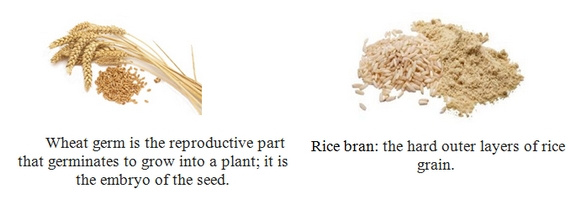
How does it work?
As mentioned, β-Sitosterol has a chemical structure similar to cholesterol and is able to reduce the absorption of cholesterol in the intestines, increases the fecal excretion of cholesterol and also reduces the synthesis of endogenous cholesterol. Therefore, addition of this sterol to diets rich in cholesterol is recommended and such foods enriched with beta-sitosterol are available in the market.
How does β-sitosterol reduce cholesterol absorption?
It blocks the transportation of cholesterol from plasma membrane to the endoplasmic reticulum, i.e. it blocks the movement of cholesterol into the inner chamber of the intestinal cells, thus reducing the absorption of cholesterol.
A review with the scientific findings supporting β-sitosterol mechanism of action in lowering cholesterol levels:
Elke A. Trautwein, Guus S. M. J. E. Duchateau,Yuguang Lin, Sergey M. Mel'nikov, Henri O. F. Molhuizen, Fady Y. Ntanios, Eur. J. Lipid Sci. Technol. 105 (2003) 171-185.
Other bioactivities
- It can bind to the prostate to help reduce swelling (inflammation)
- At low concentration it reduces lipid peroxidation, i.e. oxidative degradation of lipids generating free radicals that "steal" electrons from the lipids in cell membranes, resulting in cell damage
- It has anti-proliferative and anti-cancer activity, detected when cervical carcinoma cells were treated with this natural product (for further details, see: D. Cheng, Z. Guo, S. Zhang, Contemporary oncology (2015), 19/(1), 36-42)
OMEGA-3 FATS
Foods fortified with omega-3 fatty acids can be found in every supermarket!
Omega-3 fats are polyunsaturated fatty acids in which the first double bond in the hydrocarbon chain occurs between the third and fourth carbon atoms from the end of the molecule most distant from the carboxylic acid group.
They can be found in:
- Fish (as tuna and salmon), fish oils, green leafy vegetables, and some vegetable oils.

- Marine animals such as fish and krill provide eicosapentaenoic acid (EPA) and docosahexaenoic acid (DHA), which are mostly promoted for their protective effects on your heart
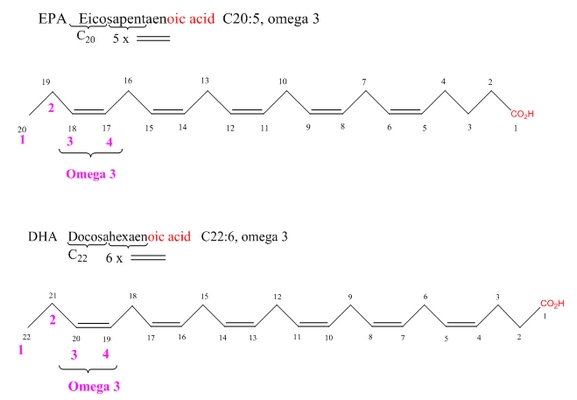
- Flaxseed, chia, hemp, and a few other foods, on the other hand, offer alpha-linoleic acid (ALA)

Most of the health benefits of omega-3 fats are linked to the animal-based EPA and DHA, not the plant-based ALA.
Omega-3 fats benefits:
- Normalization and regulation of cholesterol and triglyceride levels - Reduction of plasma cholesterol and triglyceride concentrations, inhibiting the biosynthesis of very-low-density lipoproteins (VLDL) and triglycerides in the liver, while slightly increasing that of high-density lipoproteins (HDL). The use of omega-3 fatty acids for the therapeutic lowering of triglyceride levels has emerged in order to decrease vascular risk [for scientific information, see: Vascular Health and Risk Management (2015), 11, 203-209].
- Heart health - prevention of cardiac arrhythmia, thrombosis, fatty deposits and fibrosis of the inner layer of arteries [for additional scientific information, see: D. K. Thompkinson, V. Bhavana, P. Kanika, Journal of Food Science and Technology (2014), 51(10), 2318-2330].
- Counteracting inflammation - EPA and DHA were efficient in preventing and/or treating several chronic inflammatory conditions, namely inflammatory bowel diseases and rheumatoid arthritis [further scientific information, see: S. Lorente-Cebrian, A. G. V. Costa, S. Navas-Carretero, L. M. Laiglesia, J. A. Martinez, M. J. Moreno-Aliaga, Journal of Physiology and Biochemistry (2015), 71(2), 341-349].
- DHA affects child's learning and behavior - This nutrient is found in breast milk contributing to baby's normal physical brain and eye development. Recommended levels of DHA are present in infant milk available in the market. DHA is a major lipid in the brain recognized as essential for normal brain function. In animals, low brain DHA results in impaired learning and behavior. In infants, as montioned above, DHA is important for optimal visual and cognitive development. In childhood, which is a period of brain growth and maturation, relationship of DHA with measures of learning and behavior in healthy school-age children could also be found. Benefits of DHA supplementation were confirmed in at least one area of cognition or behavior, suggesting an important role for DHA in school performance [for scientific information, see: C. N. Kuratko, E. C. Barrett, E. B. Nelson, N. Salem, Nutrients (2013), 5(7), 2777-2810]
- Brain health - EPA and DHA keep the dopamine levels in the brain high, increase neuronal growth in the frontal cortex of the brain, and increase cerebral circulation. Recently, the benefits of omega-3 fatty acids in the prevention against major depression, bipolar disorders, and post traumatic stress disorder have been reviewed [scientific information, see: K. P. Su, Y. Matsuoka, C. U. Pae, Clinical Psychopharmacology and Neuroscience (2015), 13(2), 129-137].
- Obesity prevention - Increasing metabolism and fat burning potential, omega-3 fats also seem to suppress appetite [for additional scientific information, see: B. Gray, F. Steyn, P. S. Davies, L. Vitetta, European Journal of Clinical Nutrition (2013), 67(12), 1234-1242].
OMEGA-6
The name results from the position of the double bond, as shown below for linoleic acid.
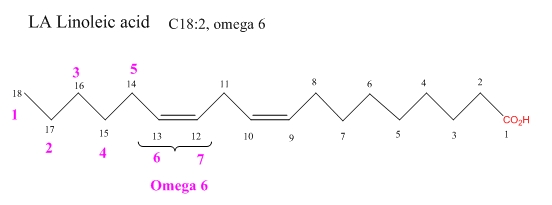
It can be found in:
- Corn, soy, canola, safflower, and sunflower oils, which are overabundant in some diets, accounting for excess in omega-6 levels.

Both omega-3 and omega-6 are fats that are essential for human health.
The ideal ratio of omega-6 to omega-3 fats is 1:1. Today, this ratio averages in some countries from 20:1 to 50:1 and the lack of omega-3 is then a serious problem.
Experts believe that one reason for high incidence of heart disease, hypertension, diabetes, obesity, premature aging, and some cancer forms today may be a profound omega-3-omega-6 imbalance.
For more information on omega-3 and omega-6, see "What type of fat should I choose".
What are Antioxidants?
These molecules have a diversity of structures but an extensive group of antioxidants has a radical scavenging activity, and reacts with highly reactive and unstable free radicals to generate harmless species.
What is a free radical?
It is a molecule that contains an unpaired electron and will capture an electron from other substances in order to become a stable molecule, generating another radical derived from the substance that supplies the electron.
How do radicals act?
Radicals are capable of attacking healthy cells leading to cell damage and severe disorders. This process contributes to ageing, and to a number of diseases, namely cancer, heart diseases, brain dysfunction, decline in immune system, among others.
Where do we find natural antioxidants? What can we eat for the consumption of antioxidants?
Foods, herbs and spices can be rated according to their Oxygen Radical Absorbance Capacity (ORAC) value, developed by the National Institutes of Health in Baltimore, which measures the antioxidant capacity of foods.
Antioxidants are worth considering in our diet aiming at overall health and wellbeing!
A spice with a very high ORAC value: Cinnamon ground (within ORAC Top five list)
Cinnamon
The genus Cinnamomum comprises of several hundreds of species distributed in Asia and Australia. Cinnamomum zeylanicum is an indigenous tree of Sri Lanka and the source of cinnamon bark and leaf oils, although most oil now comes from cultivated areas. C. zeylanicum is an important spice. However, it is known that cinnamon showed decline in antioxidant properties following cooking. This aromatic crop has wide applications in flavoring, perfumery, beverages, and medicines.
Volatile oils from different parts of cinnamon were found to exhibit antioxidant, antimicrobial, and antidiabetic activities.
What are essential oils?
Essential oils are concentrated aromatic volatile compounds derived from plants by distillation or mechanical pressing. They play multiple roles as antioxidants, food pathogen inhibitors, shelf-life enhancers, texture promoters, organoleptic agents and toxicity-reducing agents. For their versatility, they appear promising as food preservatives.
Cinnamon essential oils' potential were investigated as functional ingredients in meat and fish processing. Chemical analysis showed that cinnamon tea has a high antioxidant capacity, which may be due to its polyphenol content. C. zeylanicum bark and fruits contain proanthocyandins with doubly linked bisflavan-3-ol units in the molecule, such as cinnamtannin B-1.
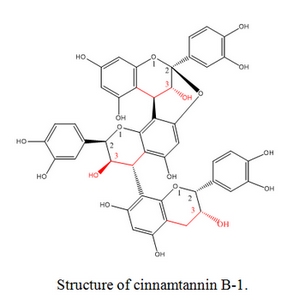
Proanthocyanidins are naturally occurring compounds that exhibit a large number of cellular actions mostly derived from their antioxidant activity. These cellular actions include antitumoral activity, antithrombotic action through inhibition of the endogenous ROS (reactive oxygen species, radicals) generation, Ca2+ mobilization, and subsequent aggregation of platelets. These compounds were also used to treat neurological disorders associated with tau aggregation such as Alzheimer's disease. They bind tau and inhibit its aggregation. Considering the large number of cellular effects of cinnamtannin B-1, this compound needs to be further investigated for the development of therapeutic strategies based on its use for thrombotic disorders or certain types of cancer
[For further scientific information on cinnamon, see: G. K. Jayaprakasha, L. J. M. Rao, Critical Reviews in Food Science and Nutrition (2011), 51, 547-562].